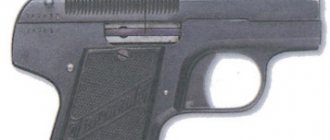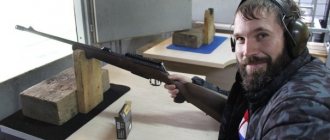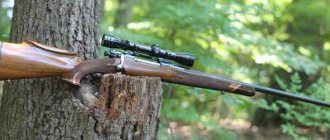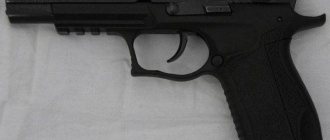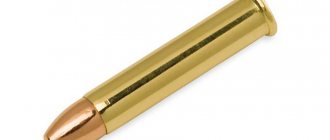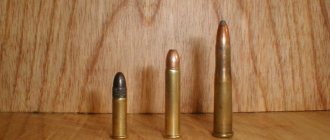Hunting enthusiasts often complain about problems associated with the heavy weight of the rifle and the barrel being too long. At first glance, there is no particular difficulty in carrying your weapon. But after several hours of travel and covering long distances, the body gradually begins to get tired. If the hunt takes place not in the field, but in the forest, another concern is added: a long trunk clings to branches, slowing down movement.
In this regard, the relevance of a serious modernization of hunting rifles is clear. As a result of technical improvements carried out back in Soviet times, carbines appeared on the arms markets - modifications of hunting weapons. The significantly reduced weight and barrel length of many models are approved by both amateur hunters and professionals involved in serious fishing.
The most famous carbine of the USSR
In Soviet times, the Simonov self-loading carbine (SKS) was especially popular among hunters. Work on it began back in World War II. Despite the fact that this carbine was initially planned as a weapon for cavalry, it, having proven its reliability in operation, became more widely used in the Soviet and later in the Russian army. During the war, the carbine was also used by partisan units to resolve local military conflicts.
This small weapon has two modifications that allow reloading automatically and manually. The second option is considered hunting. This is due to the fact that SKS can most often be found among hunters, as it has many valuable qualities. The advantages of Simonov's self-loading carbine are its ease of operation, shooting accuracy, and reliability, which are confirmed by reviews from owners. VPO-208, created according to the SKS principle, is its improved version.
Upgraded SKS
The Vyatsko-Polyansky machine-building plant “Molot”, based on the Simonov self-loading carbine, created a similar, but already modernized version of the new small arms. The modified VPO-208 carbine is identical in appearance, weight and overall dimensions to the SKS.
The new model differs from its counterpart in its new smoothbore barrel, caliber and purpose. Some reviews from VPO-208 owners contain the statement that the service life of the modified barrel allows no more than five thousand shots to be fired from this carbine.
In the design of the classic version of the Simonov self-loading carbine, only the barrel is new, equipped with an internal “Paradox” attachment (125-135 mm) and six right-hand rifling, which have a beneficial effect on the accuracy of fire. In addition, the muzzle of the carbine barrel has a special thread for attaching flash suppressors or other muzzle devices. Everything else in the model remains the same. Carbine-208, the photo of which is presented below, has proven its effectiveness in practice.
Review #1
Externally, the carbine is not much different from its combat predecessor, unless, of course, you look closely at the inscriptions on the receiver.
Disassembly also confirmed complete identity with the prototype, the only difference being the barrel. The VPO-208 has a smooth barrel with a rifled muzzle 14 cm long. It is the fact of partial rifling according to the “paradox” type that made it possible to classify the VPO-208 as a smooth-bore weapon, but in terms of accuracy, accuracy of fire and lethality it comes close to a rifled weapon
This attracted the attention of a large army of hunters and shooters who had not achieved “rifled experience.”
Rifles in the muzzle of the barrel.
Examining in detail the long-familiar design, I am once again convinced of the complete authenticity of this sample of Simonov’s self-loading carbine, with the exception, of course, of the barrel. At the same time, I also highlight some nice additions from the manufacturer, such as an external thread at the end of the barrel (covered with a protective sleeve), allowing future owners to use various DTK (muzzle brake compensator) to improve shooting parameters.
The thread on the muzzle is covered with a sleeve.
The main focus of testing was the desire to try out the new product in action, so I went to the shooting range.
Unfortunately, of the several possible options for .366 TKM bullet cartridges, only polymerized lead bullets were available, but I think that will be enough for now.
.366 TKM cartridges. Lead bullet with polymer coating.
Having previously studied the forums and the reviews that appeared, I was mentally prepared for troubles in the form of frequent delays (non-ejections), associated primarily with the quality of the cartridge, and not with the design of the carbine, which has been proven over decades. Looking ahead, I will say: having shot a pack (20 rounds), I received only 2 delays. But the trouble has just begun, everything will definitely be finalized over time, better components will arrive, and the range of cartridges themselves will expand significantly, and short-term shortages in gun stores will become a thing of the past.
I chose 50 and 100 meters for shooting distances; there is no point in shooting further without an optical sight, especially since they are the most efficient, both at the shooting range and during hunting.
I check the quality of the factory adjustment of mechanical sights with several shots, at the same time getting used to the trigger and tactile sensations. The descent is long, but smooth - a feature of all SKSs, and not of a specific sample. The recoil is quite soft, despite the heavy bullet, and practically does not disturb the insert, which facilitates quick readiness for the second shot. The sound of the shot is a “pleasant bass” (there is not that ear-piercing crackle like the original cartridge), it is quite comfortable to shoot without headphones. The mechanical rear sight, left on the carbine from the progenitor, is marked up to adjustments of 1000 meters, which in our case is not relevant, but the very fact of being able to select the required position of the rear sight for a certain distance is very important.
Next, I shoot in series of 5 shots at the specified distances.
The series at 100 meters, although subject to wind drift, turned out to be more uniform in the spread of the group of hits, without separation, since it was shot without delay from one tab.
A series of 50 meters vertically fit quite compactly into 2-2.5 cm, but the horizontal was stretched due to a delay in the process of completing the series and, accordingly, a change of tab.
At the same time, the accuracy indicators turned out to be excellent: if at fifty meters they are comparable to a very well-prepared smoothbore weapon, then at a hundred meters they are in no way inferior to the SKS carbine in its native rifled caliber, and perhaps even surpass it.
Group of hits at a distance of 50 m.
Group of hits at a distance of 100 m.
Presentations of the new smoothbore model SKS
For the first time, an improved model of the Simonov self-loading carbine was presented on May 21, 2015. The venue for the presentation of VPO-208 was the Nevsky Sports Complex. The organizers of the demonstration were the Hammer Weapons enterprise and the Tekhkrim arms company, which deals with ammunition. During the presentation, the best examples of VPO-208 carbines and 366 TKM ammunition were shown. The test firing results demonstrated the high capabilities of the modified SKS model and ammunition.
The second show of VPO-208 smoothbore carbines took place on August 11, 2015. The place for the demonstration was the “French Shooting Club” in Mytishchi. During shooting, a high accuracy rate was noted: from a distance of one hundred meters, the bullets lay 1 cm apart from each other. After the second presentation, the serial production of this model was announced.
Weapons chambered for 366 TKM
VPO-208
The first weapons created for the 366 TKM caliber cartridge were the VPO-208 and VPO-209 carbines produced by Molot-Oruzhie LLC.
The VPO-208 carbine is based on the Simonov self-loading carbine (SKS) and is its complete analogue, with a replaced barrel chambered for 366 TKM cartridge and a modified ammunition magazine. The bolt, trigger mechanism, butt, everything is completely from the SKS carbine.
VPO-209
The VPO-209 carbine was created on the basis of a Kalashnikov assault rifle, the barrel was replaced with a smooth one with Paradox-type rifling, the ability to fire automatic bursts was removed, and the magazine for cartridges was modified.
VPO-212
The VPO-212 carbine is based on the Vepr-Pioneer rifled hunting carbine (SOK-97-R). It is a smoothbore weapon. All characteristics correspond to those of the rifled Vepr-Pioneer: wooden hunting stock, barrel 520 or 650 mm long, push-button safety and detachable magazines for 5 or 10 rounds.
VPO-213
The VPO-213 carbine is based on the VPO-148 carbine; the carbine uses a heavy receiver from a Kalashnikov light machine gun with a heavy barrel. The carbine is available in 6 barrel lengths from 350 to 700 mm. There are modifications with a folding buttstock on the left and right sides, as well as a modification with a telescopic buttstock. The carbine has a side Picatinny rail, as well as a Picatinny rail on the receiver cover for mounting sighting devices.
AK-366-Lancaster
, which is also located in the city of Vyatskie Polyany, Kirov region, also developed its weapons chambered for 366 TKM. To create its AK-366, AKS-366 and SKS-366 weapons, the company also used the SKS carbine and the Kalashnikov assault rifle, but did not use a barrel with Paradox rifling, but barrels with Lancaster drilling. The barrel with a Lancaster drill has an oval cross-section, which is twisted along the entire length of the barrel, making a full turn in 50 cm.
The AK-366-Lancaster, in its design, is almost completely identical to the VPO-209 carbine, the only difference is in the barrel, “Lancaster” instead of “Paradox”.
SKS-366-Lancaster
A smoothbore carbine based on the Simonov self-loading carbine, it differs from military weapons only in the barrel chambered for .366 TKM and the Lancaster barrel drilling.
AKS-366-Lancaster
The AKS-366-Lancaster smoothbore carbine is based on the Kalashnikov assault rifle with a folding stock (AKMS). It differs from the base weapon in that it lacks the ability to fire automatically in bursts and has a barrel chambered for the .366 TKM cartridge and a Lancaster barrel drill.
The AKS-366-Lancaster carbine has several modifications that differ from each other in small nuances; the basic modification has a stock that folds down, the AKS-366-Lancaster-02 modification has a frame stock that folds to the left, and the AKS-366-Lancaster-03 modification has a shortened stock barrel, like a Kalashnikov AKS assault rifle. Otherwise, all modifications are identical.
Kalashnikov TG2
The Kalashnikov concern also did not stand aside and created its own model of weapons chambered for the 366 TKM cartridge. The Kalashnikov TG2 smoothbore self-loading carbine is based on the Saiga self-loading carbine chambered for 7.62x39. Externally, the TG2 carbine is similar to the AK-103 combat assault rifle.
The forend and butt of the Kalashnikov TG2 are made of impact-resistant plastic, the butt folds to the left. The length of the TG2 carbine when folded is 705 mm, when unfolded it is 945 mm, the weight of the carbine is 3.5 kg. The barrel of the Paradox carbine is 415 mm long. There is a side Picatinny rail for attaching sighting devices. The carbine comes with a plastic magazine for 10 rounds.
Components of the modernized SKS
The design of the VP-208 smoothbore carbine contains the following elements:
- carbine barrel;
- receiver with lid;
- chamber for powder gases;
- bolt core;
- trigger mechanism;
- return mechanism;
- barrel lining;
- piston;
- spring-loaded pusher;
- carbine magazine;
- a special feeder with a spring that supplies small arms with ammunition;
- sighting devices.
Performance characteristics
The VPO-208 smoothbore carbine is equipped with a new barrel. It is designed to fire modern Russian 336 TKM cartridges:
- carbine length with barrel – 1025 mm;
- barrel length – 520 mm;
- carabiner width – 61 mm;
- the VPO-208 carbine has a magazine that can hold 10 rounds of ammunition, certified for use with smooth-bore weapons;
- the light weight of the barrel (3.65 kg) makes it much easier to carry during hunting;
- the sighting range is 300 m.
The VPO-208 smoothbore carbine, the photo of which is presented in the article, has quite understandably earned high popularity.
The design of the smoothbore gun is much more elegant than that of the Simonov self-loading carbine. In the new version of the small arms, the stock has a semi-pistol shape. Walnut is used to make it. In addition, there are special notches on its surface that prevent possible slipping. As evidenced by reviews from VPO-208 owners, the carbine with a modified stock is very comfortable to use. The design makes it possible to attach special devices for optics to it.
How does the VPO-208 carbine work? Description
The hammer-type firing mechanism allows for single shots with subsequent installation on the safety catch. The principle of automation is based on the operation of powder gases discharged through holes in the side wall of the barrel. When the bolt moves beyond the receiver lug, the barrel is locked. The bolt is located on the bolt frame, on the right side of which there is a charging handle.
A manual safety lever in the trigger guard ensures safety during operation. The carabiner can be easily and quickly removed from the safety lock using your thumb. The magazine is loaded while the bolt is open. The carbine magazine is non-removable and is equipped with special clips consisting of ten rounds for smooth-bore shooting.
The complete set can be carried out with both clips and single cartridges. The sight is represented by a front sight, which can be adjusted in two planes, and an aiming bar. The carbine has a wooden stock and a butt, in the back of which there is a container for a special pencil case. All accessories necessary for caring for the weapon are placed in it.
Advantages of the Vyatsko-Polyana model
Reviews from owners of the VPO-208 indicate that on the Russian market it is significantly superior to other models of smooth-bore hunting rifles. The advantage of the carbine is its high accuracy of fire. In the absence of optics, at a distance of one hundred meters, the accuracy of hits ranges from eight to ten centimeters. The use of a large-caliber bullet with high muzzle energy significantly increases the lethality of the VPO-208. Reviews from owners confirm an important advantage of this small weapon - the lethal effect of the bullet when hunting large ungulates. Today, any citizen of the Russian Federation can purchase such a carbine. To do this, it is enough to have a license to own a smooth-bore long-barreled weapon.
pros
– Energy. A heavy 15 gram bullet (there is also a 13.5 g polymer, but this is purely on paper and trifles) did the 39 cartridge good. Compare for yourself. We take my native 12 gauge and my favorite (but unavailable after the rise of the currency) “sovestr”. If there are 12 cal on the cut of the trunk. has 3200 J, and the VPO has 2800, then at 50 meters both guns have 2400 J, and at 100 m the Sovester has 1800 J, the VPO has about 2000. So I beg to differ with the skeptics that this gun is not suitable for elk will do. In our team, there are cases of elk being caught at 80 m with a smooth feathered bullet. I lay down confidently enough. In VPO, the SP15 cartridge in the ballistic environment opens into a “ball” with a diameter slightly less than 5 ruble coins. This should be enough. But all these reports only apply to the SP15 cartridge. And the most popular among people now is “lead in polymer,” which has much less energy and does not open normally. I don’t see any point in shooting at anything larger than a wolf or a goat.
- Accuracy. Yes, it shoots and quite accurately. With proper skill, it’s possible to do it in three minutes. That is, about 10 cm per 100 m. The passport indicates 70 mm per 100 m from the machine. And this is a standard (“Tekhkrim” makes them semi-handicraft before starting the rotary machine) cartridge, which varies in weight, shape, etc. With normal the result will be 100% better. I can't promise, but I'll aim for two minutes. With my 12 gauge I can't produce anything even close to that. No, I, of course, have heard a lot (and in my hunting team too) that almost every first one hits just as well at 100 m from his smooth one. But for some reason in practice it turned out to be a little different. Something close in accuracy can only be achieved by a competent self-rolling 410 from a very advanced owner with a selected hitch, etc., but at 100 m it will have an energy of 800 J, not 2000.
– Lots of available tuning. Everything from the SKS fits; for example, I changed the stock to an ATish one (Monte Carlo) and am happy. Optics are pampering at the shooting range, I’ll hang a collimator or a 1-4x fence on the pen.
– Reliability. After troubleshooting the new (!) carbine and bringing it into divine shape, it is a reliable, unpretentious machine, just like dad - SKS.
– Legal reloading. Smoothbore, however. Already now matrices, bullets, etc. are being developed for the new caliber. There will be recipes and equipment.
- Cartridges. “Tehkrim” is really (no joke!) actively “finishing” the new cartridge. Now something quite acceptable is already happening. I'm sure they will finish it within a year.
As a result, I still don’t regret the purchase. Moreover, in the next 3 years I will not be able to purchase anything comparable in terms of accuracy/energy. And the manufacturer’s idea is great. A short, reliable carabiner. We took the SKS and added energy and AP to it. Well done, someone's got a headache. And yes, it was in vain that they left the 10-round magazine. For the paddock season, I’ll buy a detachable ProMag with 5 rounds and it will be very good. In general, I tried to unsubscribe honestly, don’t judge strictly.
By presenting these notes on the eve of the new season, we hope that at the end of it, it will finally be possible to publish the story of the owner of VPO-208 about the real use of a veteran who has regained his second youth on wild game hunting.
Scope of application of VPO-208
Reviews from amateur and professional hunters confirm that the improved model of the Simonov self-loading carbine is one of the best among many models of small hunting weapons. The Vyatsko-Polyanskaya model of carbine is also suitable for shooting at a shooting range. At a distance of one hundred meters you can hit both game and target. At the same time, an acceptable accuracy of hits from VPO-208 is observed. Reviews from owners about this carbine are extremely positive. The legislation of the Russian Federation allows for independent reloading of its cartridge. This allowed the VPO-208 to take its rightful place among other models of long-barreled small arms.
Review #2
On one of the Russian hunting forums we found a review from the owner of this carbine. This is what the user “Slushkov” writes:
– I am the owner of the desired device. I first heard about the presentation (June 2015) and was looking forward to the start of sales. I bought it just to be able to shoot at 100-150 m. I didn’t have time to try it on a real hunt, because... Receiving the ROC for this device just coincided with the end of the season, and there was simply nowhere to test it.
In general, below I will describe the negative and positive aspects of its use. And draw your own conclusions - whether to buy or not.
Next, user “Slushkov” describes the pros and cons of this carbine.
Production of cartridges for a new carbine model
For hunting animals whose weight does not exceed 200 kg, 336 TKM cartridges are used. They are used to equip integral magazines for the VPO-208 carbine.
For convenience when purchasing, the characteristics of cartridges are indicated by the abbreviation TKM, which contains information about the developers and manufacturers.
The development of cartridges is carried out by Tekhkrim CJSC in the city of Izhevsk. The creator of the ammunition for the VPO-208 carbine is designated by the abbreviation TK. M denotes the manufacturer of the smooth-bore version of the SKS - OJSC Molot (Vyatskie Polyany).
The basis for the production of 336 TKM carbine cartridges is the 7.62X39 mm cartridge case manufactured in 1943. It is a model for the manufacture of a new version of the cartridge, which has a caliber of 9.5x37.5 mm. Bullet weight varies from eight to fifteen grams. With a weight not exceeding fifteen grams, when flying out of the barrel, the bullet is capable of developing an initial speed of 570 to 590 m/s. Its kinetic energy varies from 2440 to 2610 J. The bullet can be shell and semi-shell.
Minuses
– Carbines are made from SKS, which come from warehouses. They change the barrel, and that's it. You may get an unused “new” one that has been in storage, or maybe a donor with two repair marks. I consider this a minus.
– It follows from the previous one: upon purchase, a new carbine should be completely disassembled, soak everything in kerosene and wd40. Mine got paint off the springs and also washed off some dirt (from the Vietnam War?). Be sure to check all springs, etc. Agree, getting acquainted with a new gun begins with the purchase of a complete repair kit (at SKS) and a thorough troubleshooting of the weapon, for which you paid 41,000 rubles. (I bought it when it had just appeared, and at an extortionate price tag), somehow it’s not entirely great.
– Apart from the barrel, nothing was changed in the carbine, while the magazine remained chambered for the 7.62x39 cartridge, and at first there were cases of the bullet nose sticking when fed. By the way, this also happens with SCS, and it is treated in exactly the same way. 20 minutes of work with pliers, and everything starts to flow great.
- Cartridges. This is a huge temporary disadvantage. More precisely two minuses. First, Tekhkrim currently does not have time to produce cartridges in the required quantity. Severe shortage. They promise to launch a rotary line any moment now and fill the Motherland with cheap (up to 20 rubles) cartridges, but so far only words. With a carbine, the store gives 100-200 pieces and that’s it. Thanks to acquaintances in a couple of ormags, I managed to grab, in addition to the standard 200 (I got the sp15 half-shell), excess cartridges (used in shoot-outs), but in general the people have a fierce grudge against “Techkreem.” And secondly, the quality of these same cartridges. The caliber is new, it was not fully tested, and there were technical problems. First there were issues with gunpowder (it burned poorly at minus, the bullet speed jumped), then with the primer. It misfired in the cold. Plus, by the end of the year, the bullets were poorly crimped, and periodically (about 1%) a bullet, after firing the primer, flew into the barrel, passed through its smooth part and hung on the rifling. The gunpowder did not ignite and fouled all the insides of the carbine. The bullet was knocked out with a ramrod. There was a case when a certain shooter, after spitting into the barrel like that, did not check the bore and fired with a second cartridge. As a result, the barrel ruptured (to Tekhkrim’s credit, they replaced the barrel on that carbine at their own expense). Although there was a terrible mistake with TB on the shooter’s part, in my opinion.
- Mortar. I thought for a long time and noted that this fact needs to be described. The bullet is quite heavy, and, despite its good speed, it sags quite strongly. That is, vertical corrections when shooting AFTER 100 m must be made. The situation is somewhat reminiscent of hunting pneumatics. The bullet still has good energy to hit the target, but the trajectory forces corrections. There is no need to enter corrections up to 100 m. With my optics height (70 mm above the barrel level) from 50 to 100 m, vertical deviations are up to 3 cm, and I ignore them. The first zero is about 50, the second zero is about 90 m, at 100 m the drop is 3 cm. In the same elk, I think it won’t matter.
Ammo shells used
The production of cartridges for the Simonov self-loading carbine and its modernized version is carried out by flaring an existing sample, the caliber of which is 7.62X39 mm. As a result of processing, a caliber of 9.5 mm is achieved, the length is 0.366 inches. To complete the newly created cartridges, shot and bullet shells are used, which, depending on the task, are fired by the VPO-208 smoothbore carbine. Reviews from owners confirm the effectiveness of such cartridges, which are new on the arms market.
On the shelves of hunting and weapons stores, 366 TKM caliber shells are presented in four types:
- LSWCPC. Contained in a polymer shell and equipped with a lead bullet. The use of polymer significantly reduces the lead content of the carbine barrel. The bullet weight is 13.5 grams.
- FMJII. A blunt jacketed bullet weighing 11 grams is used.
- FMJI5. The pointed jacket bullet in this projectile weighs 15 grams.
- SP. A semi-jacketed bullet weighing 15 grams is used.
Reviews from Tyumen owners of the VPO-208 carbine, as well as their recommendations, allow us to conclude that for hunting large ungulates and bears, cartridges equipped with a semi-jacketed bullet, which can be used at a distance of 150 m, are more suitable.
Shot shells for the VPO-208 carbine weigh 20 grams. They are used for hunting game birds and small animals. The presence in the assortment of both bullet and shot shells indicates the versatility of this small arms, in the production of which all the wishes and feedback of consumers were taken into account.
.366 TKM cartridges
Cartridge .366 TKM "Cone"
The first semi-jacketed bullet called “Cone” for the 366 TKM cartridge was created in 2015. The “Cone” bullet had a conical shape, a brass shell, very soft lead due to which it was easily deformed at the target. Bullet weight 15 grams, initial bullet speed 600 m/s, bullet energy 2700 J. Accuracy at 100 meters 80 mm.
Cartridge .366 TKM "Dary"
In 2015, cartridges with a cast bullet “Dary” with two grooves appeared; a little later, to improve accuracy, the shape of the groove was removed. The bullet is made of harder lead. The bullet has a polymer coating, which reduces the friction of the bullet in the bore, reduces the lead lining of the barrel, reduces heating and extends the service life of the weapon. Cartridges with a Dary bullet are intended for hunting animals weighing from 10 to 100 kg at a distance of up to 150 m and for target shooting. Bullet weight 15 grams, initial bullet speed 550 m/s. Accuracy at 50 meters 75 mm.
Cartridge .366 TKM "Gexa"
In 2016, cartridges with the Hexa expansion bullet appeared. The bullet has a brass jacket, a profiled jacket with a thick bottom. The bullet has six longitudinal concentrators to facilitate the expansion of the bullet into the target. The Hexa bullet is a hunting bullet with a good stopping effect, good expansion and mass retention when hitting the target. Bullet weight 15.5 grams, initial bullet speed 550 m/s, bullet energy 2334 J. Accuracy at 50 meters 45 mm.
Cartridge .366 TKM "SP13"
The cartridge with the SP13 bullet was also certified and put into production in 2016. The SP13 bullet is a semi-jacketed bullet with a lead nose. The ogival shape of the front of the bullet is better suited for hunting purposes than the previously released semi-jacketed "Cone" bullet. The bullet jacket is brass, the bullet core is made of soft lead. In 2022, a modification weighing 15 g was released with a bimetallic shell and an expansive recess in the nose of the bullet. Bullet weight 12.6 grams, initial bullet speed 620 m/s, bullet energy 2746 J. Accuracy at 50 meters 60 mm.
Cartridge .366 TKM "FMJ"
In 2022, the "FMJ" type bullet was released, it consists of a soft lead core covered with a tombac jacket. The “FMJ” type bullet is intended for hunting small game species, since when passing through soft tissue it does not deform and does not leave serious damage to the body of the game. The FMJ bullet is well suited for recreational target shooting. Bullet weight 14 grams, initial bullet speed 600 m/s. Accuracy at 50 meters 65 mm.
Cartridge .366 TKM "Etna"
A cartridge with a copper bullet of the expansive type "Etna" was released in 2017. The Etna bullet has a special profiled cavity in its nose, which provides programmable expansion of the bullet at a depth of 2-2.5 bullet lengths after the bullet hits the target. The Etna bullet has a high stopping effect. To improve aerodynamics and accuracy, the hole in the bullet nose is covered with a fairing. Bullet weight 12 grams, initial bullet speed 810 m/s. Accuracy at 50 meters 80 mm.
Cartridge .366 TKM "Eco"
The cartridge with the ECO bullet was certified and put into production in 2022. The “ECO” bullet is very light, it weighs only 6.5 grams, the bullet material is soft zinc alloy. The bullet has a flat trajectory. The bullet has a conical shape, which was done to improve the full load in standard AK magazines. The internal rear cone and two knurled grooves on the cylindrical part of the bullet, according to the manufacturer, reduce barrel wear and ensure good accuracy. The cartridge with the "ECO" bullet is intended for target shooting, but can be used in hunting small animals. Bullet weight 6.5 grams, initial bullet speed 810 m/s. Accuracy at 50 meters 80 mm.
Cartridge .366 TKM with Kion bullet
In 2022, the Kion semi-jacketed bullet was released with a radius shape with an expansive recess and a durable bimetallic jacket with a thick layer of copper, 0.45 mm thick, to uniformly open the bullet when it hits the target, maintain bullet weight and reduce barrel wear. Bullet weight 13 grams, initial bullet speed 650 m/s. Accuracy at 50 meters 40 mm.
Shot cartridge .366 TKM No. 10
In 2022, Techkrim also released a shot cartridge with number 10 shot. The cartridge has a bullet-shaped plastic container filled with shot, which protects the lead shot when the cartridge is fed and is destroyed when passing through the “paradox”. According to the manufacturer, .366 TKM No. 10 cartridges are intended for hunting small game birds at a distance of up to 25 m.
The Techkrim company is constantly working to expand the range of 366 TKM cartridges and improve previously released cartridges. You can get acquainted with the products offered by Techkrim on the company’s official website.
Advantages
The predominant number of positive qualities of any product allows it to compete with its analogues. The VPO-208 carbine also took its place on the market among other small arms. Owner reviews highlight the strengths of the new model:
- The relatively affordable price of the barrel is 25 thousand rubles. The cartridges used for this weapon are considered budget, since their price, compared to bullet cartridges, is low.
- Ease of use. The improved stock does not slip in your hands. The shortened barrel does not interfere with movement. The recoil when shooting is almost not felt, which is important for novice hunters and novices.
- The presence of bullet and shot shells makes it possible to hunt small and large game.
- Since the modernized VPO-208 is produced on the basis of the classic Simonov self-loading carbine, the new model of small arms is a collector's item.
- According to the law of the Russian Federation, persons who have already owned carbines for at least five years have the right to purchase a VPO carbine. In the case of VPO-208, this restriction does not apply. According to the legislation of the Russian Federation, a license for smooth-bore small arms is sufficient to purchase this carbine. Having it, you can purchase a VPO-208 carbine, which is in no way inferior in power to rifled weapons. Now you don't have to wait five years. The buyer can do this already in the first year of his hunting activity. The appearance of the VPO-208 carbine on gun counters has become a good alternative to rifled small arms.
- High accuracy when shooting: bullets fired from a distance of one hundred meters fall 5-8 cm from each other. An identical picture is observed when firing from the Tiger and SVD carbine.
- The VPO-208 smoothbore carbine is ideal for both hunting and target shooting.
- Great design and ergonomics.
- The use of additional sighting and muzzle devices such as optics and flash suppressors has improved the tuning of the VPO-208, which is very similar to the Simonov self-loading carbine.




